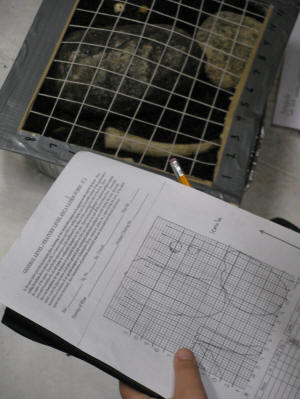|
CCSS.Math.Content.5.G.A.1 |
Use a pair of perpendicular number lines,
called axes, to define a coordinate system, with the intersection
of the lines (the origin) arranged to coincide with the 0 on each
line and a given point in the plane located by using an ordered
pair of numbers, called its coordinates. Understand that the first
number indicates how far to travel from the origin in the direction
of one axis, and the second number indicates how far to travel in
the direction of the second axis, with the convention that the names
of the two axes and the coordinates correspond (e.g., x-axis and
x-coordinate, y-axis and y-coordinate). |
|
CCSS.Math.Content.5.G.A.2 |
Represent real world and mathematical problems by graphing points
in the first quadrant of the coordinate plane, and interpret coordinate
values of points in the context of the situation. |
|
CCSS.ELA-Literacy.CCRA.R.7 |
Integrate and evaluate content presented in diverse media and
formats, including visually and quantitatively, as well as in words.
|
|
CCSS.ELA-Literacy.CCRA.R.9 |
Analyze how two or more texts address similar themes or
topics in order to build knowledge or to compare the approaches
the authors take. Anchor Standards |
|
CCSS.ELA-Literacy.CCRA.SL.1 |
Prepare for and participate effectively in a range of conversations
and collaborations with diverse partners, building on others’ ideas
and expressing their own clearly and persuasively. |
|
CCSS.ELA-Literacy.CCRA.SL.2 |
Integrate and evaluate information presented in diverse media
and formats, including visually, quantitatively, and orally. |
|
CCSS.ELA-Literacy.CCRA.SL.4 |
Present information, findings, and supporting evidence
such that listeners can follow the line of reasoning and the organization,
development, and style are appropriate to task, purpose, and audience. |
|
CCSS.ELA-Literacy.CCRA.SL.5 |
Make strategic use of digital media and visual displays of data
to express information and enhance understanding of presentations.
|
|
CCSS.ELA-Literacy.CCRA.SL.6 |
Adapt speech to a variety of contexts and communicative tasks,
demonstrating command of formal English when indicated or appropriate. |
|
CCSS.ELA-Literacy.RI.4.1 |
Refer to details and examples in a text when explaining what
the text says explicitly and when drawing inferences from the text.
|
|
CCSS.ELA-Literacy.RI.4.3 |
Explain events, procedures, ideas, or concepts in a historical,
scientific, or technical text, including what happened and why,
based on specific information in the text. |
|
CCSS.ELA-Literacy.RI.4.7 |
Interpret information presented visually, orally, or quantitatively
(e.g., in charts, graphs, diagrams, time lines, animations, or interactive
elements on Web pages) and explain how the information contributes
to an understanding of the text in which it appears. |
|
CCSS.ELA-Literacy.RI.4.9 |
Integrate information from two texts on the same topic
in order to write or speak about the subject knowledgeably. |
|
CCSS.ELA-Literacy.RI.4.10 |
By the end of year, read and comprehend informational texts,
including history/social studies, science, and technical texts,
in the grades 4–5 text complexity band proficiently, with scaffolding
as needed at the high end of the range. |

